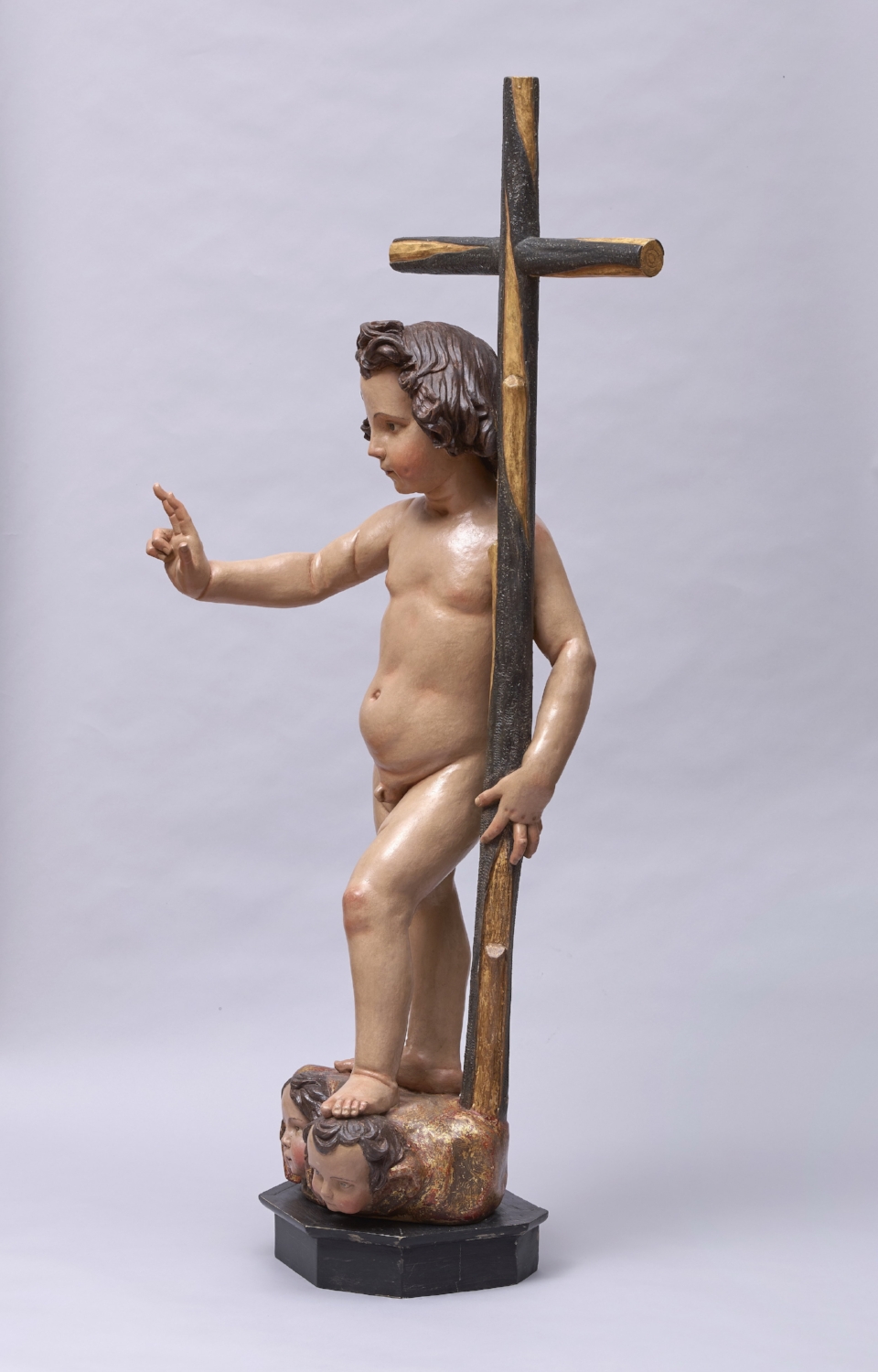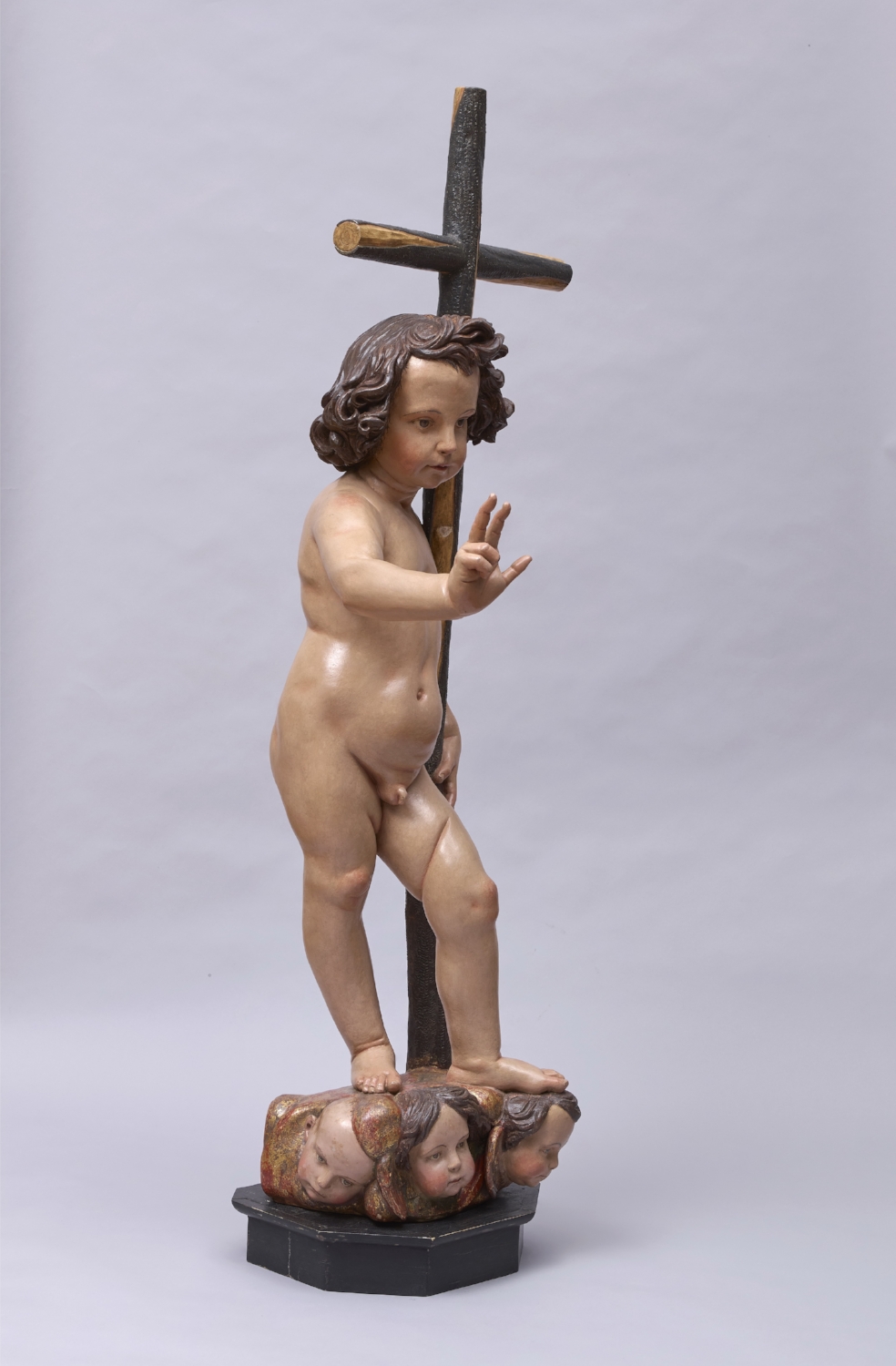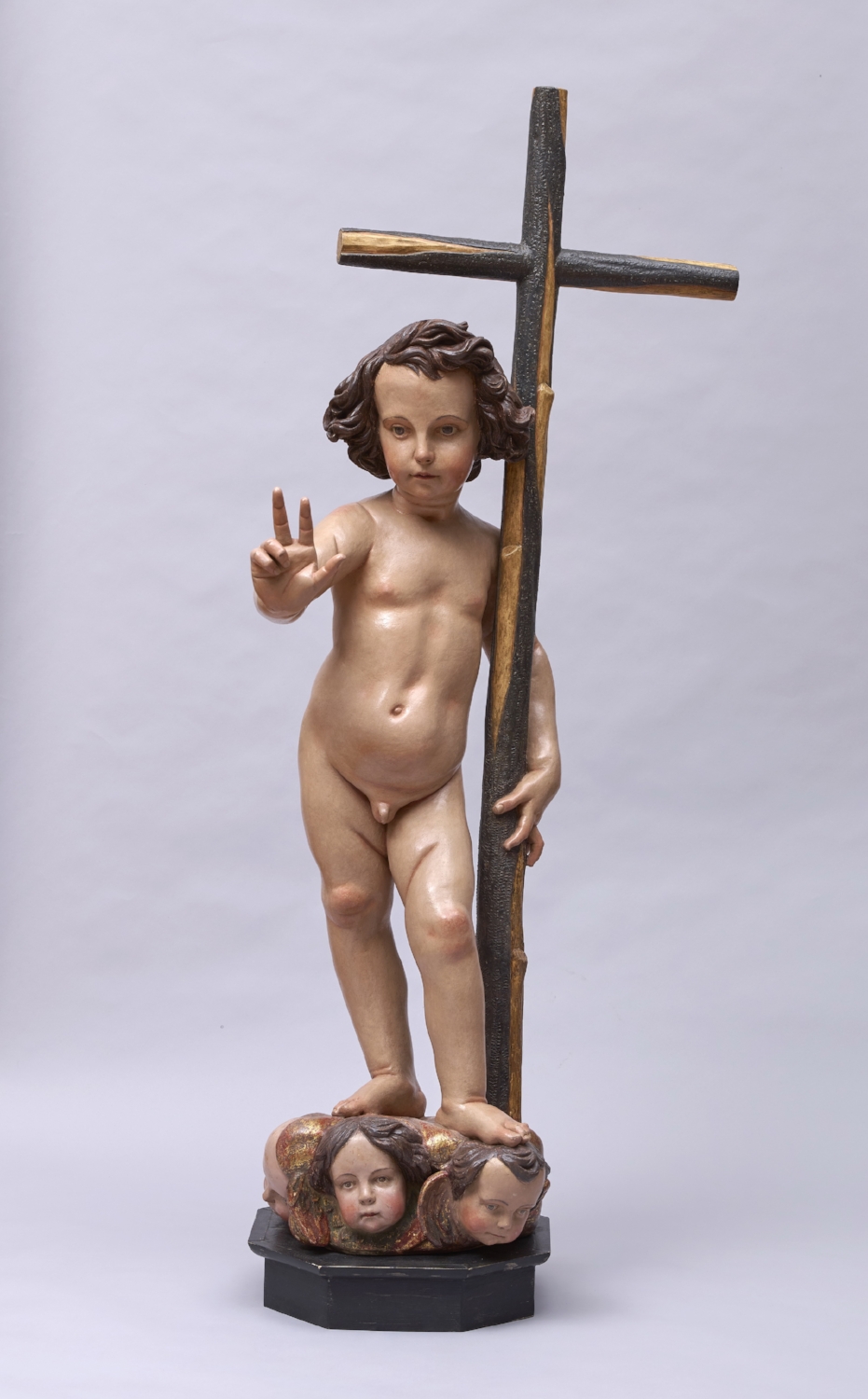FRANCISCO DIONISIO DE RIBAS
(Córdoba, 1616 - Sevilla, 1679
Infant Jesus in triumph
Ca. 1640-1650
Polychrome wood, 120 x 40 x 38 cm
The atmosphere after the Council of Trent, which defended and exalted the Eucharistic dogma and issued the famous decree on sacred images, as is well known, was the ideal environment for the development and definitive success of certain iconographical typologies that moved to devotion. Particularly appropriate were in this sense the subjects of children in relation to sacred characters, which acquire great development since then. The case that we study is a good example of what has been commented here. In this sense, the devotional iconography that represents Jesus the Savior as a child, in an individualized manner and carrying the Cross and symbols of the Passion, as well as St. John the Baptist with the labarum and the lamb that prefigures Christ are two of the most successful typologies in the sculpture school of Andalusia in the 17th Century. Particularly, in the Seville school, where the fundamental prototypes would be created and repeated basically during the whole 17th Century, producing a large number of examples of varying quality. In this sense, one must mention Juan Martínez Montañés (Jaén, 1568- 1649), the great sculptor of the school of Seville during the first half of the 17th Century. He is the author of one of the models of the naked and standing Infant Jesus that was the most repeated during the first third of the 17th Century by re-interpreting in a more naturalistic manner the first documented image of this type of iconography that is kept in Andalusia. This image was executed towards 1582 by the sculptor Jerónimo Hernández, from Avila, for the Sevillian Brotherhood of the Sweet Name of Jesus (Dulce Nombre de Jesús - today of the Quinta Angustia) with a marked praxitelean contrapposto of mannerist character. The following step in the evolution of the iconographical type towards an elegant, refined and serene naturalistic classicism is found in the chisel of Martínez Montañés when he sculpted the magnificent Infant Jesus for the sacramental brotherhood of the Church of the Sagrario, Seville, around 1606-1607. The figure by Montañés would become the leading example and reference model for this iconographic typology, repeated in numerous copies and versions by the disciples and followers of the sculptor from Jaén.
Towards the mid-1630’s the Flemish sculptor José de Arce established himself in Seville, after a sojourn in Rome. Since then, the interpretations of the subject are renovated by the influence of his novel style of modeling -softer, more dynamic and monumental- in the younger sculptors who had been educated in the circle of Montañés-Mesa, such as the Ribas.
The present work is undoubtedly inscribed among these characteristics. It is possible to find in it many stylistic, formal and technical features as well as typological models and similarities that are typical of the two sculptors of the family, Felipe and Francisco Dionisio Ribas. Felipe de Ribas was born in Córdoba in 1609; his early education must have begun with his father, a modest occasional painter. They established in Seville in 1621 where Felipe, the eldest son, was a student at the workshop of Juan de Mesa, learning to sculpt and specializing in altarpieces, under the strong influence of Montañés. Later on, Alonso Cano was also a great influence and Felipe would collaborate with him on many projects. His younger brother Francisco Dionisio worked closely with Felipe and continued to lead the family workshop after the death of his older brother. Another brother, Gaspar, worked with them as well and as a painter was responsible for much of the polychrome work on his brothers’ sculptures.
This work presents an elegant contraposto with one leg placed forward, which gives the figure a sinuous movement. He is blessing with his right hand while he holds and leans on the Cross. He is standing on a plinth formed by heads of angels. As we mentioned before, this Infant Jesus is related to the work of the sculptors and brothers, mostly to some examples and versions of this same subject. All of them, including this one, are inspired by Jerónimo Hernández’s Child, more than by the one by Martínez Montañés. Among them, we will mention the Infant Jesus from the Museo Nacional de Escultura (Valladolid) considered to be by Felipe de Ribas. The distinctive way of carving the folds on the flesh of the calves is common to both works (Fig. 1). Also very typical of both brothers is the way the hair is carved, abandoning the attention for details as influenced by Montañés, in order to shape it by volumes of compact masses and less detailed locks of hair. This is the type of modeling that had been introduced by José de Arce, from where they also take the human type of the Child with its plump shapes, as well as its proportions, with an elongated torso (Fig. 2). An Annunciation by Felipe de Ribas made for the Convent of the Conception of Lebija in 1638, now in a private collection, shows comparable faces of angels (Fig. 3). Very close to the work that we study is the Infant Jesus that Francisco Dionisio de Ribas donated to the Hermandad de la Amargura of the parish of San Juan de la Palma in 1644, polychromed by his brother Gaspar (Fig. 4). In addition to its proximity in disposition and attitude, also the type of the face, the carving of the hair and the plinth with its heads of angels are very close to this triumphant Infant Jesus. In this same line we can also mention another Child by Francisco Dionisio in the Museo de Bellas Artes de Sevilla, which shares identical technical and aesthetic values (Fig. 5); or the one attributed to him at the Hispanic Society in New York (Fig. 6).
A particular feature that is worth pointing out about the sculpture studied here is its size, much larger than the rest of the mentioned versions.
Fig. 1 Felipe de Ribas, Niño Jesús, Museo Nacional de Escultura
Fig. 1A Felipe de Ribas, Niño Jesús, Museo Nacional de Escultura (Detail)
Fig. 2 José de Arce, Niño Jesús, , Antigua colección del Marqués de Aracenay Hermandad de Ntro. Padre Jesús el Nazareno, Iglesia de San Bartolomé de Carmona, Sevilla
Fig. 2A José de Arce, Niño Jesús, , Antigua colección del Marqués de Aracenay Hermandad de Ntro. Padre Jesús el Nazareno, Iglesia de San Bartolomé de Carmona, Sevilla (Detail)
Fig. 3 Felipe de Ribas, Anunciación, Convento de la Concepción, Lebrija. Sevilla. Hoy en Colección privada
Fig. 4 Francisco Dionisio de Ribas, Niño Jesús, Iglesia de San Juan de la Palma, Sevilla
Fig. 5 Francisco Dionisio de Ribas, Niño Jesús, Museo de Bellas Artes de Sevilla
Fig. 6 Francisco Dionisio de Ribas (atrib.), Niño Jesús, Hispanic Society, Nueva York













